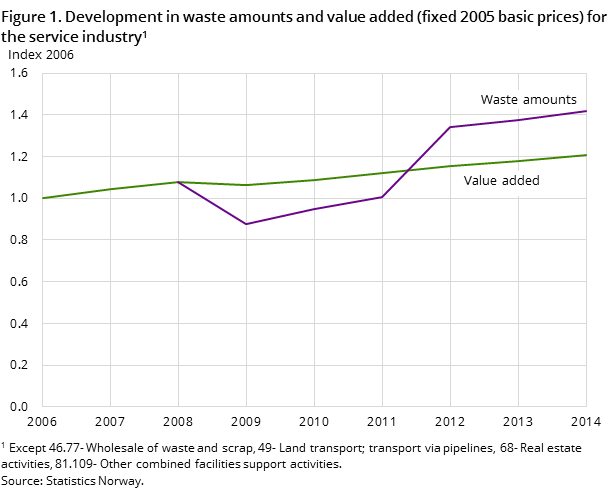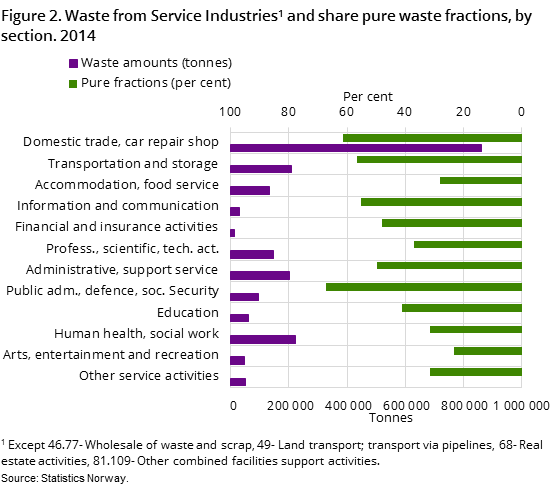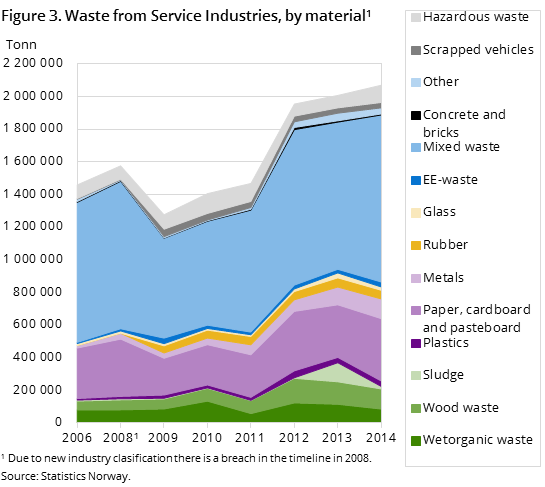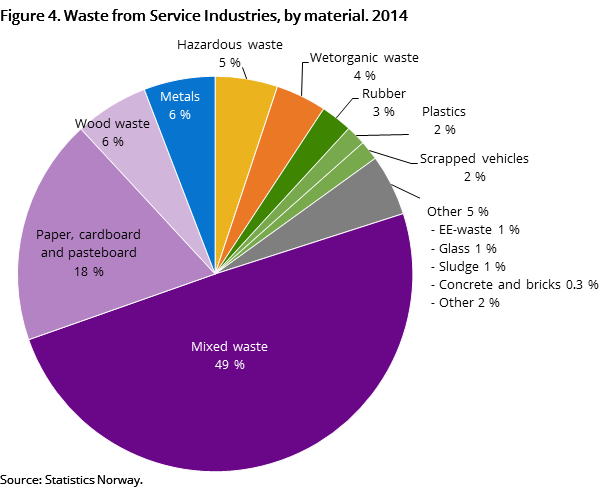Content
Published:
This is an archived release.
Small growth in waste from service industries
The service industries generated just short of 2.1 million tonnes of waste in 2014. As before, the domestic trade business had the largest share of the waste, with almost 42 per cent.
| Tonnes | Per cent | Per cent | ||
|---|---|---|---|---|
| 2014 | 2013 - 2014 | 2008 - 2014 | ||
| Waste amounts by material | ||||
| In total | 2 070 652 | 100.0 | 3.2 | 31.4 |
| Mixed waste | 1 023 156 | 49.4 | 13.5 | 13.3 |
| Paper, cardboard and pasteboard | 382 089 | 18.5 | 18.5 | 8.7 |
| Wetorganic waste | 85 628 | 4.1 | -25.3 | 6.1 |
| Hazardous waste | 105 448 | 5.1 | 38.0 | 28.2 |
| Other materials | 474 331 | 22.9 | -19.8 | 200.2 |
| Waste by section | ||||
| In total | 2 070 652 | 100.0 | 3.2 | 31.4 |
| Wholesale and retail trade: repair of motor vehicles and motorcycles | 860 579 | 41.6 | 8.4 | 33.9 |
| Human health and social work activities | 222 733 | 10.8 | -28.6 | 11.3 |
| Administrative and support service activities | 200 503 | 9.7 | 22.0 | 18.2 |
| Other service sections | 786 837 | 38.0 | 6.8 | 39.7 |




The waste amounts from the service industries increased by just over three per cent from 2013 to 2014. Mixed waste is still the largest waste fraction, with 49 per cent of the total waste. For the first time, this waste category exceeds 1 million tonnes.
The waste amounts from the service industries have increased by 42 per cent since 2006. In comparison, the value added (fixed 2005 basic prices) for the industry increased by only 21 per cent during the same period. This means that the industry has become less waste efficient during the last eight years.
Most waste from the domestic trade business
More than 860 000 tonnes of waste, or nearly 42 per cent, came from the domestic trade business in 2014. Second and third in magnitude are human health and transportation and storage, with 11 and 10 per cent of the total waste amounts respectively.
Increase in hazardous waste, decrease in sludge
Despite the small increase in waste from 2013 to 2014, some waste fractions are increasing. Hazardous waste increased the most from 2013 to 2014, by 38 per cent, and EE waste and paper had the second and third largest increases.
Despite the general increase in waste amounts, some waste fractions have decreased. The waste categories that decreased the most in terms of percentage are sludge followed by glass and wet organic waste, with a reduction of 87, 33 and 25 per cent respectively.
Service industriesOpen and readClose
Service industries is a collective term that includes wholesale and retail trade, hotels and restaurants, transport, storage and communication, financial intermediation, real estate, renting and business activities, together with public and personal services. This corresponds to section G-U in the Standard Industrial Classification (SIC2007). For the time being, the statistics cover section G-S, except 46.77- wholesale of waste and scrap, 49- land transport; transport via pipelines, 68- real estate activities.
Uncertainty in the figuresOpen and readClose
The calculations are based on customer registers from a sample of waste collectors. Some of the customers probably delivered some pure waste fractions to waste collectors outside the sample, or to collectors outside the waste collection business. The total amount of waste and the amount of pure fractions may therefore be too low, while the share of mixed waste may be too high.
Contact
-
Camilla Skjerpen
E-mail: camilla.skjerpen@ssb.no
tel.: (+47) 48 22 72 14
-
Gisle Berge
E-mail: gisle.berge@ssb.no
tel.: (+47) 48 12 19 97
